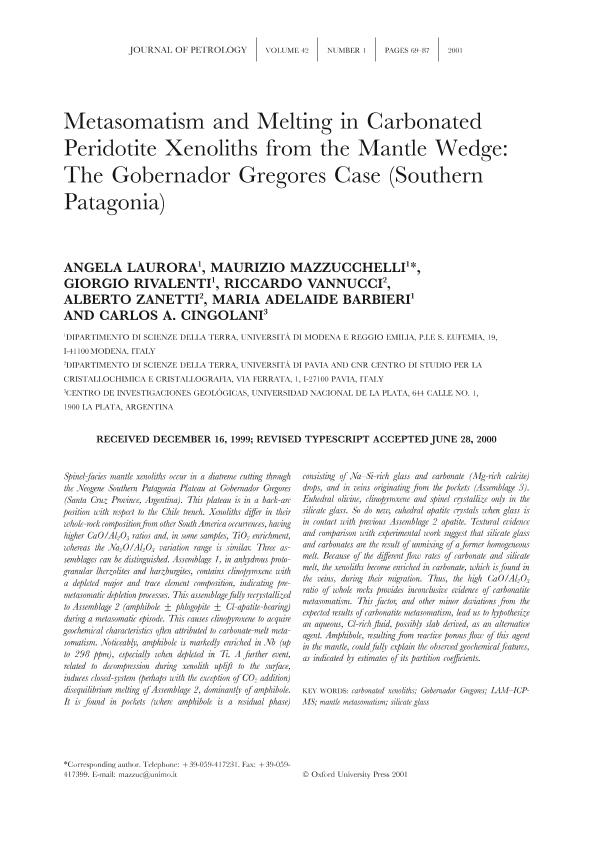Mostrar el registro sencillo del ítem
dc.contributor.author
Laurora, Angela
dc.contributor.author
Mazzucchelli, Maurizio
dc.contributor.author
Rivalenti, Giorgio
dc.contributor.author
Vannucci, Riccardo
dc.contributor.author
Zanetti, Alberto
dc.contributor.author
Barbieri, María Adelaide
dc.contributor.author
Cingolani, Carlos Alberto

dc.date.available
2019-04-11T23:28:58Z
dc.date.issued
2001-01
dc.identifier.citation
Laurora, Angela; Mazzucchelli, Maurizio; Rivalenti, Giorgio; Vannucci, Riccardo; Zanetti, Alberto; et al.; Metasomatism and Melting in Carbonated Peridotite Xenoliths from the Mantle Wedge: The Gobernador Gregores Case (Southern Patagonia); Oxford University Press; Journal of Petrology; 42; 1; 1-2001; 69-87
dc.identifier.issn
0022-3530
dc.identifier.uri
http://hdl.handle.net/11336/74189
dc.description.abstract
Spinel-facies mantle xenoliths occur in a diatreme cutting through the Neogene Southern Patagonia Plateau at Gobernador Gregores (Santa Cruz Province, Argentina). This plateau is in a back-arc position with respect to the Chile trench. Xenoliths differ in their whole-rock composition from other South America occurrences, having higher CaO/Al2O3 ratios and, in some samples, TiO2 enrichment, whereas the Na2O/Al2O3 variation range is similar. Three assemblages can be distinguished. Assemblage 1, in anhydrous protogranular lherzolites and harzburgites, contains clinopyroxene with a depleted major and trace element composition, indicating pre-metasomatic depletion processes. This assemblage fully recrystallized to Assemblage 2 (amphibole ± phlogopite ± Cl-apatite-bearing) during a metasomatic episode. This causes clinopyroxene to acquire geochemical characteristics often attributed to carbonate-melt metasomatism. Noticeably, amphibole is markedly enriched in Nb (up to 298 ppm), especially when depleted in Ti. A further event, related to decompression during xenolith uplift to the surface, induces closed-system (perhaps with the exception of CO2 addition) disequilibrium melting of Assemblage 2, dominantly of amphibole. It is found in pockets (where amphibole is a residual phase) consisting of Na–Si-rich glass and carbonate (Mg-rich calcite) drops, and in veins originating from the pockets (Assemblage 3). Euhedral olivine, clinopyroxene and spinel crystallize only in the silicate glass. So do new, euhedral apatite crystals when glass is in contact with previous Assemblage 2 apatite. Textural evidence and comparison with experimental work suggest that silicate glass and carbonates are the result of unmixing of a former homogeneous melt. Because of the different flow rates of carbonate and silicate melt, the xenoliths become enriched in carbonate, which is found in the veins during their migration. Thus, the high CaO/Al2O3 ratio of whole rocks provides inconclusive evidence of carbonatite metasomatism. This factor, and other minor deviations from the expected results of carbonatite metasomatism, lead us to hypothesize an aqueous, Cl-rich fluid, possibly slab derived, as an alternative agent. Amphibole, resulting from reactive porous flow of this agent in the mantle, could fully explain the observed geochemical features, as indicated by estimates of its partition coefficients.
dc.format
application/pdf
dc.language.iso
eng
dc.publisher
Oxford University Press

dc.rights
info:eu-repo/semantics/openAccess
dc.rights.uri
https://creativecommons.org/licenses/by-nc-sa/2.5/ar/
dc.subject
Carbonated Xenoliths
dc.subject
Gobernador Gregores
dc.subject
Lam-Icp-Ms
dc.subject
Mantle Metasomatism
dc.subject
Silicate Glass
dc.subject.classification
Geología

dc.subject.classification
Ciencias de la Tierra y relacionadas con el Medio Ambiente

dc.subject.classification
CIENCIAS NATURALES Y EXACTAS

dc.title
Metasomatism and Melting in Carbonated Peridotite Xenoliths from the Mantle Wedge: The Gobernador Gregores Case (Southern Patagonia)
dc.type
info:eu-repo/semantics/article
dc.type
info:ar-repo/semantics/artículo
dc.type
info:eu-repo/semantics/publishedVersion
dc.date.updated
2019-03-18T14:43:31Z
dc.identifier.eissn
1460-2415
dc.journal.volume
42
dc.journal.number
1
dc.journal.pagination
69-87
dc.journal.pais
Reino Unido

dc.journal.ciudad
Oxford
dc.description.fil
Fil: Laurora, Angela. Dipartamento Di Scienze Della Terra, Universitá Di Modena e Reggio Emilia, Modena ; Italia
dc.description.fil
Fil: Mazzucchelli, Maurizio. Dipartamento Di Scienze Della Terra, Universitá Di Modena e Reggio Emilia, Modena ; Italia
dc.description.fil
Fil: Rivalenti, Giorgio. Dipartamento Di Scienze Della Terra, Universitá Di Modena e Reggio Emilia, Modena ; Italia
dc.description.fil
Fil: Vannucci, Riccardo. Dipartamento Di Scienze Della Terra, Universitá Di Pavia and Cnr Centro Di Studio per la Cristallochimica e Cristallografia, Via Ferrata, Pavia ; Italia
dc.description.fil
Fil: Zanetti, Alberto. Dipartamento Di Scienze Della Terra, Universitá Di Pavia and Cnr Centro Di Studio per la Cristallochimica e Cristallografia, Via Ferrata, Pavia ; Italia
dc.description.fil
Fil: Barbieri, María Adelaide. Dipartamento Di Scienze Della Terra, Universitá Di Modena e Reggio Emilia, Modena ; Italia
dc.description.fil
Fil: Cingolani, Carlos Alberto. Consejo Nacional de Investigaciones Científicas y Técnicas. Centro Científico Tecnológico Conicet - La Plata. Centro de Investigaciones Geológicas. Universidad Nacional de La Plata. Facultad de Ciencias Naturales y Museo. Centro de Investigaciones Geológicas; Argentina
dc.journal.title
Journal of Petrology

dc.relation.alternativeid
info:eu-repo/semantics/altIdentifier/doi/http://dx.doi.org/10.1093/petrology/42.1.69
dc.relation.alternativeid
info:eu-repo/semantics/altIdentifier/url/https://academic.oup.com/petrology/article/42/1/69/1461703
Archivos asociados
